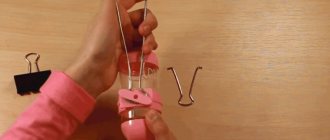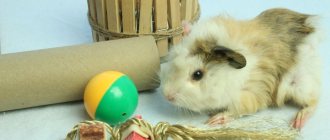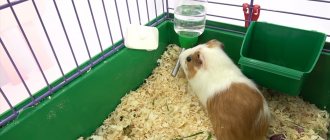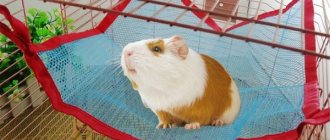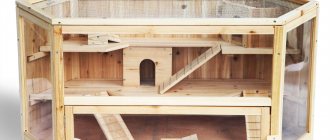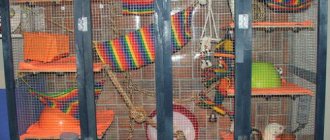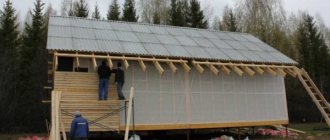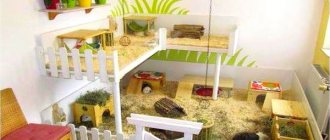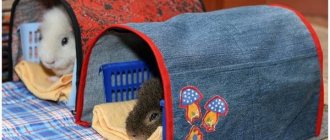Surely many have encountered the problem of purchasing cages for guinea pigs, because the prices are high, the furnishings of such a home are meager and the sizes are not always suitable. Therefore, it is best to build a home for your pet with your own hands, based on spatial and design preferences.
Setting Up a Guinea Pig Cage Sorry, there are no surveys available at this time.
Purchased and DIY cage
Whether to buy a cage for your rodent or make one yourself depends on the financial situation and personal preferences of the owners. If you have the finances, you can choose nickel-plated metal products in the store, which will differ:
- long service life;
- spacious dimensions;
- attractive appearance.
Such a cell is almost impossible to damage. As for the materials for making terrariums, the following is used:
- organic glass;
- getinax;
- synthetic materials.
Rizhik in a hammock
All these materials are durable, hygienic and safe. In addition, they are resistant to mechanical damage and chemical elements.
The bottom of the cage must be strong. It is best if it is made of high-quality and environmentally friendly plastic.
Attention! Cages made from combined materials are not particularly durable. Despite their low cost, it is better to opt for other products.
As for the option of making a cage yourself, here you can build a structure of any size and from different materials.
The advantages of making a rodent cage yourself include:
- saving your own savings. You can make a spacious and easy-to-use house for a whole family of guinea pigs;
- interesting shapes and designs. When manufactured independently, the product can be given any shape and different types of structures can be made. This can be a two-level housing with stairs and various shelters;
- aesthetic appearance. Properly designed housing for rodents will harmoniously fit into any room interior.
Another advantage of a homemade cage is that over time you can improve the design by adding new levels or a house.
As for the shape, the animal cage can be made in the shape of the letter L, vertical, horizontal and even multi-story. From the remaining materials after assembling the cage, it will be possible to make a house, a crib, or a feeding trough.
The main thing is to competently develop a drawing, select materials, and stock up on free time.
Adviсe
So, what you need to consider:
- The cage must be equipped with everything necessary, otherwise the pet will not feel comfortable.
- For the bottom, use corrugated cardboard, plastic or other durable material that the pig cannot chew through.
- The iron for the grill must be as strong as possible, otherwise your pet will chew through it without any problems.
- Clean the cage regularly to prevent bacteria and disease.
- The cage must be made in such a way that it can be disassembled and washed without any problems; take this into account when assembling.
- The larger the space, the more comfortable the animal is.
- The air temperature in the room where the rodent is kept should be around 22 degrees. It shouldn't be too hot or cold here.
Cage dimensions
Making a house for a guinea pig begins with determining its size. Here it is worth starting from the fact that the animal is comfortable and cozy in its home. The larger the living space, the better the animal will be.
For a comfortable stay, the minimum cage dimensions should be:
- for one pet 100 x 70 cm;
- for two pigs – 140 x 70 cm;
- for three animals – 170 x 70 cm;
- for four or more pets – 210 x 70 cm.
DIY guinea pig cage
Attention ! if in the future you plan to breed pigs, then the dimensions of their housing should be 170 x 70 cm or more.
Requirements for living conditions
It is not advisable to make multi-level houses for older pigs
When choosing the size of the cage, the characteristics of the room where it will be installed are taken into account. Most often, apartments do not have enough space for a spacious home for guinea pigs. But there are minimum requirements that are recommended to be met.
| Number of animals | Minimum area, cm2 |
| 1 | 0.7 (100x70 cm) |
| 2 | 0.98 (140x70 cm) |
| 3 | 1.19 (170x70 cm) |
| 4 | 1.47 (210x70 cm) |
If a pair was acquired (a boy and a girl), then one should remember about possible offspring. Therefore, the cage size must be designed for 4 or more guinea pigs.
The height of the walls should be at least 40 cm. If the animal stands on its hind legs, it should not reach the top of the wall.
Before designing, it is recommended to take into account other features:
- The place where the house will be installed must be dry, clean and well ventilated. It is advisable for people to gather in this room. Hearing human speech, animals adapt faster.
- The cage should be installed on a flat surface.
- If there are other pets living in the apartment, then the guinea pigs need a ceiling. It will protect them from aggression from other animals or fallen objects.
- The rodents' home should be well lit and away from heat sources.
- In the room where the guinea pigs will live, the air temperature should be 22 degrees and the air humidity should be 50%. Slight deviation in both directions is allowed.
- For walls, it is recommended to choose a metal grid. If you use solid material (for example, fiberboard), it will limit the flow of air and natural light.
- The minimum distance between the gratings should be 1.5 cm, the maximum - 2.5 cm.
If you want to paint the rods, you need to choose a paint that will not harm the health of the guinea pig, since they have a habit of gnawing on various objects.
How to build and equip?
Before you begin the work process, you should make a competent drawing. This drawing should indicate the dimensions of the product and indicate the materials for its manufacture. Next you will need to prepare the necessary materials and tools:
- plywood for making a pallet (you can also use any plastic container as a pallet, for example, a photo tray);
- metal grate. Its cells should be no more than 3 cm for adults, and no more than 1 cm for small piglets;
- furniture nails;
- packaging of plastic cable ties;
- scissors;
- roulette;
- jigsaw;
- pencil.
The height of the base of the product must be at least 15 cm, and the length and width of the structure can be any, but not less than those indicated above.
The production of the cell is carried out in the following sequence:
- Draw on the plywood the shape of the future base of the product, according to the drawing.
- Using a jigsaw, cut out the necessary parts.
- Secure them with furniture nails.
After completing all the steps, you will have a plywood pallet. Assembling a cage for a guinea pig is carried out in the following sequence:
- We take a previously assembled rectangular plywood pallet with 15-centimeter sides.
- At the corners we attach posts made of wooden blocks.
- We cut the metal mesh into panels of the required size.
- We connect the finished panels with the base and posts using slats.
That's the whole simple process of making a cage for guinea pigs with your own hands. Now you need to arrange the interior space for a comfortable and happy life for your pets.
The arrangement of the cage begins with the placement of feeders. Your guinea pig should have three different feeders for:
- hay;
- dry food;
- juicy food.
Hay
Next, we attach the drinking bowl. Drinkers and feeders, as well as hay boxes, can be purchased ready-made at a pet store.
Now you can move on to arranging the play area and recreation. Guinea pigs love houses, hammocks, ladders, mazes, toys and balls. The ladder can be made of metal gratings or wood.
Necessary materials
- Multilayer and dense corrugated cardboard,
- Metal mesh or lattice with a mesh no larger than three centimeters,
- Ordinary plastic cable ties,
- Knife,
- Scotch tape,
- Large and small scissors
- Pencils or markers for marking,
- Ruler.
It is best to use cardboard from large household appliances. It's more durable.
To ensure that the cardboard does not allow moisture to pass through, it must be glued on the inside with tape in two or three layers. Some people prefer to cover the inside with acrylic or even fiberglass. Cardboard is an ideal material - it is light, easy to work with, odorless and harmless, and also easy to find. You should be careful when choosing a metal mesh. The recommended mesh is three centimeters, but if you are keeping a family of pigs and planning to produce offspring, you must choose a mesh with a mesh no larger than a centimeter. Otherwise, the kids will crawl all over the apartment.
How to make a house with your own hands?
Of course, you can buy a house for your pet in the store. But if you do it yourself, you will save money and build a spacious and beautiful house for your pet. Clay flower pots, wooden or plywood products are suitable for these purposes.
You can make a house from corrugated cardboard. To do this you will need:
- corrugated cardboard;
- glue (non-toxic);
- stationery knife.
The process of its manufacture consists of the following stages:
- We cut out the walls of the house. Don’t forget to immediately make windows and doors in them.
- We connect the walls.
- Attaching the roof.
- We place the house in the cage. It is better to install the product at the side of the cage.
Building a plywood house would also be an excellent choice. It can be one or two-level, with partitions and windows. In other words, when making it, owners can show a full flight of imagination.
In fact, you can make a house for your pet from any available materials. These can be wooden mansions, a house made of plastic pipes, products made from natural fabric and much more.
Assembling a structure for guinea pigs
Having found out the required size, you can begin drawing the drawing. First, mark the volume and shape of the pallet on thick cardboard. Add at least 15 cm on each side, connect all the measured points with a line, these will be the sides of the future house.
First, mark the volume and shape of the pallet on thick cardboard
Using a knife, make cuts along the marked fold lines, but do not try to cut all the way through. Cover the top with tape, making sure that no gaps appear.
Bend the cut piece along the lines and fasten the sides with tape to make the structure more durable. Please note that it is better to wrap the outside of the bottom with several layers of adhesive tape, carefully pressing it into the cardboard. Thus, the first part is ready.
Clean the grate until completely smooth. Roll up the frame, securing the edges with a plastic tie, free the tail, which needs to be trimmed. The next step is to install the lattice part into a plywood frame-pallet. Next comes the arrangement of the interior space. Here you will need all your imagination and design ingenuity. Set up a home for rodents, make it cozy and individual.
Believe me, cleaning such a cage will be much more convenient than ready-made options sold in the store. Besides, what could be better than creating and arranging housing for your beloved pet. When will you be able to try yourself in such a role?
Two-story
In order to make a two-story cage, you must first:
- Make a drawing.
- Next, it is transferred to the tree, after which all the necessary parts are cut out.
- Then the frame is prepared: connect four bars together to form a rectangular shape.
- The height of the base must be at least ten centimeters.
Then the floor of the first floor is made on the frame. It can be plywood or wood. Next, the bars are screwed to the corners of the base in a vertical position. The horizontal bars, in turn, are attached to the vertical bars, on which the floor of the second tier will be located. A hole is cut in it so that there is a passage between the levels. A wall is attached to the back.
The roof and door of the cage are made at the discretion of the owner. On the second floor there are large windows covered with metal mesh. This way you can observe what your pets are doing.
Advantages of a large cage
What is the advantage of large houses for these animals? The answer is simple and straightforward. A spacious cage is not a pet’s pampering, not a luxury, but just a necessity. Some experts are convinced that these animals should generally be kept in enclosures, and not in cages at all, because they are quite mobile by nature. In addition, large cages do not need to be cleaned as often as small ones. A small house gets clogged faster than a large one. Therefore, even more filler will be needed. If an animal has a place to run and exercise, then this will make it many times happier and healthier.
